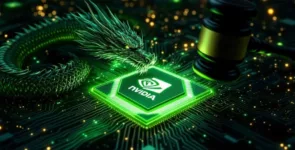In the global race for technological supremacy, no company casts a longer shadow than NVIDIA. Its GPUs have become the undisputed engine of the AI revolution, transforming the company from a high-end gaming chipmaker into a geopolitical linchpin. But with great power comes great scrutiny, and NVIDIA now finds itself in the crosshairs of its largest and most determined rival. China’s recent charge that NVIDIA is an illegal monopoly is far more than a simple antitrust filing; it is a calculated move in the ongoing U.S.-China tech war, with profound implications for the entire semiconductor industry.
While it’s easy to dismiss this as political posturing, it’s crucial to analyze the move on its merits, understand who stands to gain and assess the very real pressure building against the world’s most important technology company.
The Facts Behind the Accusation
From a purely objective antitrust standpoint, China’s case is not without merit. The core of any monopoly charge rests on market dominance and anti-competitive behavior, and on the surface, NVIDIA checks several boxes. Globally, NVIDIA controls an estimated 80-95% of the AI accelerator market. This staggering market share gives it immense pricing power, allowing it to command premium prices for its highly sought after H100 and B-series GPUs.
However, the most potent weapon in NVIDIA’s arsenal isn’t just its hardware, but its software ecosystem: CUDA. CUDA is the proprietary software platform that allows developers to unlock the full potential of NVIDIA’s GPUs for general-purpose computing. Over the past 15 years, an entire generation of AI researchers and developers has been trained on CUDA. This has created a deep and powerful “moat” around NVIDIA’s business, making it incredibly difficult and expensive for customers to switch to a competitor’s hardware, which would require rewriting years of code. This vendor lock-in is a classic hallmark that attracts the attention of antitrust regulators worldwide.
Ironically, U.S. export controls have further complicated the situation. By restricting the sale of top-tier AI chips to China, Washington forced NVIDIA to create less powerful, China-specific variants like the H200. This has had the unintended consequence of cornering the permissible Chinese market, potentially strengthening NVIDIA’s monopoly within that specific segment and giving Chinese regulators a clear target.
The Beneficiaries of a Bruised NVIDIA
The charge against NVIDIA is a strategic move designed to create opportunities for others. The primary beneficiaries are, of course, China’s domestic technology champions. The Chinese government is pouring billions into achieving semiconductor self-sufficiency, and a legally constrained NVIDIA would provide the breathing room needed for local players like Huawei (with its Ascend AI chips), Biren Technology and Moore Threads to capture the massive domestic market. For Beijing, this isn’t just about fostering competition; it’s a matter of national security.
Outside of China, NVIDIA’s rivals are watching with keen interest. With its increasingly competitive Instinct MI-series AI accelerators, AMD stands to gain the most. Any chink in NVIDIA’s CUDA armor or any forced licensing of its technology could dramatically accelerate AMD’s market penetration. Similarly, Intel, with its Gaudi line of AI chips, would welcome any development that levels the playing field. Even NVIDIA’s own customers—the large cloud providers like Amazon, Google and Microsoft who are developing their own custom AI silicon—would benefit from a reduction in NVIDIA’s market power.
Will the Antitrust Charges Go Global?
China’s move will almost certainly have a ripple effect. The European Union, with its aggressive stance on reining in Big Tech through regulations like the Digital Markets Act (DMA), is a likely next mover. The EU has a long history of pursuing antitrust cases against dominant U.S. tech firms, and NVIDIA’s market share and the CUDA ecosystem present a textbook case for investigation.
The United States is the wild card. While the current FTC and DOJ have shown a renewed interest in antitrust enforcement, NVIDIA is also a U.S. national champion at the heart of America’s AI leadership. It’s difficult to imagine Washington taking any action that would seriously undermine its own standard-bearer in the global tech race against China. A U.S. investigation is possible, but significant penalties that would hamstring NVIDIA’s global competitiveness seem unlikely.
NVIDIA’s Dilemma and China’s End Game
Is there anything NVIDIA could have done to avoid this? Likely not. The company is caught in an inescapable geopolitical vise. Open-sourcing CUDA years ago might have fostered more goodwill, but it would have also sacrificed its single greatest competitive advantage. Complying with U.S. export controls was a legal necessity, even though it angered Beijing. NVIDIA is attempting to serve two masters who are fundamentally at odds.
The pressure from China is immense and multifaceted, combining regulatory threats with a state-sponsored push for domestic alternatives. The ultimate goal is clear: to achieve technological parity with the West in critical areas like AI. The question on everyone’s mind is when. While China has made impressive strides, closing the gap with NVIDIA is a monumental task. The consensus among many analysts is that while Chinese firms may reach hardware parity for specific AI tasks by the late 2020s (around 2028-2030), replicating the depth, maturity and broad adoption of the CUDA software ecosystem will take significantly longer.
Wrapping Up
China’s monopoly charge against NVIDIA is a hybrid weapon—part legitimate antitrust concern, part strategic lever in a broader geopolitical conflict. While the facts of NVIDIA’s market dominance are undeniable, the timing and motivation behind the charge are deeply rooted in China’s ambition for technological self-reliance. The move will undoubtedly benefit NVIDIA’s competitors, both in and out of China, and likely presages similar regulatory scrutiny from the EU. Trapped between the directives of Washington and the demands of Beijing, NVIDIA must navigate these treacherous waters with extreme care. This legal battle is more than just a corporate dispute; it’s a defining skirmish in the war for the future of technology.








